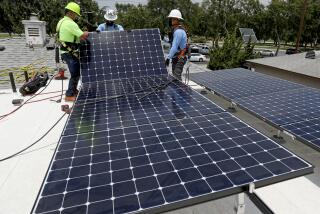Opinion: A major boost for 5G networks and public safety in California
During a response to a public safety incident or a disaster like a flood, fire or earthquake, emergency communications are vital for response and recovery. In saving lives and protecting property, minutes and seconds are critical. Teams working together must be able to communicate instantaneously.
Before, during and after a disaster or serious emergency, our organization, the California Utilities Emergency Assn. (CUEA) facilitates communications and cooperation among member communications providers, utilities and public agencies. We know firsthand how better communications can improve preparation and actual emergency response.
That is why we support SB 649 and believe it’s good for the state of California, contrary to what The Times’ editorial board argued on July 5 and columnist George Skelton contended on July 10.
SB 649 will create a clear process and fee structure for the installation of “small cell” antennas in communities across California, balancing the community’s desire for the latest, fastest wireless technology with local government’s interest in retaining oversight of the infrastructure process. The bill will help keep California communities on the cutting edge in critical communications, paving the way for the deployment of the newest technologies, including 5G, which will deliver faster connections and higher speeds.
Statewide, 5G will empower public safety and emergency services to integrate new technologies including Next Generation 911, text to 911, predictive analysis and earthquake early warning systems. And it will help to cut response times in emergencies, during which studies have shown just minutes can save lives.
But for this to work, the “small cells” or antennas that connect the system must be deployed in high-traffic areas. That’s why SB 649 is so important. It lays out transparent guidelines and clear fees, creating a path for mounting these antennas on public poles and facilities.
At the same time, it specifically requires compliance with all federal, state, and local health and safety laws and regulations. It also preserves cities’ ability to impose feasible design and collocation standards and specifically sets out exemptions for historic and coastal areas. Financially, local communities are allowed to fairly recover all of their ongoing capital and facilities costs each year, plus a $250 fee. And nothing in the bill prohibits negotiation of additional, mutually agreed terms or benefits.
Our members — who include more than 85 cities, water and irrigation districts, and utilities across the state — have worked closely with wireless companies to ensure communication facilities are established at disaster locations to enable coordination among public utilities agencies, first responders and government agencies when normal telecommunications methods may fail. Because we rely on advanced connectivity for emergency command-and-control operations, we know firsthand how important it is to support SB 649.
We need to do all we can to facilitate to the installation of the best communications networks we can in California.
This ongoing and future investment in California’s wireless infrastructure comes at no cost to taxpayers — it’s paid for with private investment — but plays a critical role in helping to advance healthcare and ensure public safety, especially for residents made vulnerable in an emergency.
In responding to emergencies and disasters, Californians set aside rivalries or self-interests to aid and comfort those in need. CUEA is proud to be part of those efforts. By supporting SB 649, we can proactively create an environment that paves the way for better wireless coverage, capacity, speed and reliability so we are even better prepared.
Don Boland is executive director of the California Utilities Emergency Assn.
This piece is part of Blowback, our online forum for rebuttals to The Times. If you would like to write a full-length response to a recent Times article, editorial or Op-Ed and would like to participate in Blowback, here are our FAQs and submission policy.
Follow the Opinion section on Twitter @latimesopinion and Facebook
More to Read
A cure for the common opinion
Get thought-provoking perspectives with our weekly newsletter.
You may occasionally receive promotional content from the Los Angeles Times.






